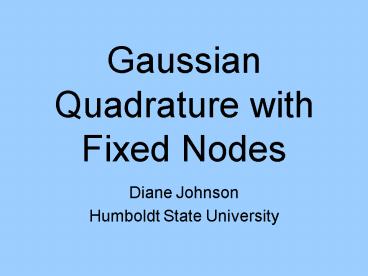Gaussian Quadrature with Fixed Nodes - PowerPoint PPT Presentation
1 / 26
Title:
Gaussian Quadrature with Fixed Nodes
Description:
Find coefficients and a free node for which. for all polynomials f of degree 3. ... Weights. If you normalize the corresponding eigenvectors, the weights are ... – PowerPoint PPT presentation
Number of Views:245
Avg rating:3.0/5.0
Title: Gaussian Quadrature with Fixed Nodes
1
Gaussian Quadrature with Fixed Nodes
- Diane Johnson
- Humboldt State University
2
General Quadrature Formula
- Example Trapezoidal Rule
where
are equally spaced nodes in a,b.
Here
,,
3
Can we find Optimal nodes and
coefficients?i.e. Can we minimize the
error?We need to understand the error1) We
derive the expression for the interpolating
polynomial2) We integrate the interpolating
polynomial to derive an expression for its error
in quadrature3) We make that error 0 for the
highest degree polynomial possible.
4
Interpolating Polynomial
- Plan Connect the dots for
Q What degree Polynomial will we need?
of Points Polynomial Degree 2 3 4 n
5
Newton Form for the Interpolating Polynomial
- To find the coefficients
- To find
by the formula
by interpolation, so
6
Newton Form for the Interpolating Polynomial
- To find the coefficients
- To find
by the formula
by interpolation, so
We write
7
Newton Interpolating Polynomial
- In a similar manner,
kth order Divided Difference
, so
Note
8
Error inPolynomial Interpolation
- Take and interpolate f at .
and
The error of the (n-1)st interpolating polynomial
at
is
9
Integrating the Interpolating Polynomial
- Define
- so
10
Divided Differences
- If f(x) constant,
- If f(x)a line,
- If f(x) a parabola,
- If f(x)polynomial of at most degree nm,
- is a polynomial of degree at most m.
- Write
- for some coefficients
11
- To make 0,
- 0
For f(x) a polynomial of degree nm
12
- Q How big can m be?
- Q How do we choose the nodes?
13
nth Degree Legendre Polynomials
14
- Choose your number of points at which to evaluate
the function (n) or the degree to which you want
your formula to be exact (2n-1) - Find the n zeros of the nth degree Legendre
polynomial - Interpolate f(x) at the n zeros
- Compute the coefficients
15
Summary
- If the are the n zeros of the nth degree
Legendre polynomial, and we interpolate f(x)
which is a polynomial of degree 2n-1 at those
points and integrate that - Since f is of degree 2n-1,
- is of degree n-1. So the integral representing
the error is zero!
16
- To find the quadrature formula above,
- a zero error term for all polynomials f(x)
of degree 2n-1. So interpolate f(x) at the zeros
of the orthogonal polynomials and integrate that - To find the coefficients Use Lagrange
interpolating polynomials
17
Lagrange Interpolating Polynomials
- We use the zeros of the Legendre polynomials
- We create (n-1)st degree polynomials
- where
- Remember that f is of degree 2n-1, is
of degree n-1 - So
- So
18
The Quadrature Formula
- We wanted a formula where
- We have a formula where
- So our coefficients are
19
Example
- Recall
- So the zeros of the 2nd degree orthogonal
polynomial are - Fact
- So for all cubics
20
Terrans Quadrature
- He found a quadrature formula where l is odd and
- for which for all
polynomials of degree - k(n1)-1. It arose from minimizing
- where the leading coefficient is one and p is a
polynomial of degree n.
21
Extending to Include Fixed Points
- Example
- Find coefficients and a free node for which
- for all polynomials f of degree 3.
22
- For all cubic polynomials f(x),
- This can be found as a solution to finding
- the best free to minimize
23
Free Nodes Coalescing
- Fact Sometimes the free nodes coincide with
the fixed nodes - Example
- has solution
- And the quadrature formula is
- which is exact for all cubic polynomials.
24
Solution
- Without coalescing
- With coalescing
- General Formula
25
Practical Determination of Gaussian Nodes
- On -1,1, the nodes are the eigenvalues of a
symmetric, tridiagonal matrix
26
Weights
- If you normalize the corresponding eigenvectors,
the weights are - Q Can a similar formulation be made for
quadrature formulae with fixed nodes?































